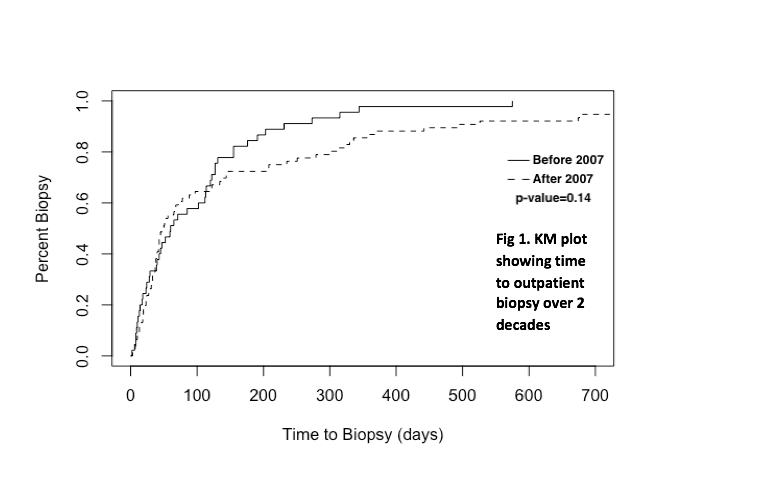Session Information
Session Type: ACR Poster Session A
Session Time: 9:00AM-11:00AM
Background/Purpose:
Proteinuria and urinary casts are good indicators of lupus nephritis (LN) yet six different LN guidelines recommend kidney biopsy to confirm LN. Therefore, kidney biopsy remains the gold standard for diagnosing LN and initiating therapy. Recent studies report an average wait time to see a specialist of 50 days which can delay biopsy and therapy in LN. There is limited information on wait times for confirming diagnosis and starting therapy in LN patients. We aimed to examine time to biopsy and therapy in LN patients and compare over two decades. We hypothesized that time to biopsy has not changed but therapy choices would differ in the decade after ALMS trial.
Methods:
Our cohort study identified all incident LN patients with initial kidney biopsy from 1997-2017 at an academic center. Sociodemographics and reported details on the first biopsy in LN patients were abstracted from a comprehensive native kidney biopsy database. Biopsy reports were reviewed for LN class and chronicity as per International Society of Nephrology guidelines. Time to biopsy and therapy were defined as time from nephrology referral until biopsy, and time from biopsy until start or change in therapy respectively. Further, for two decades we compared change in time to biopsy over 1997-2007 vs. 2007-2017, rate of hospitalization while awaiting biopsy, and type of therapy initiated.
Results:
Among 175 incident LN patients with initial native kidney biopsies, 79% were female, 72% White with median age of 24 years (2-77 years). Median times to biopsy and therapy were 52 days (24-155 days) and 7 days (0-18 days) respectively. 13% of the patients were hospitalized during the wait period. Over two decades, there was no significant change in time to biopsy (Fig 1) or hospitalization rates. Univariate and multivariate analyses showed 4 times higher odds of starting MMF in LN patients in the latter decade (OR 3.5, CI 1.2,10.8 p=0.02).Type of therapy was independent of race, proliferative LN and chronicity (Table 1). Limitations include examining only LN patients with kidney biopsy, and no data on LN patients on MMF without biopsy.
Conclusion:
This is among the first studies to report wait times for diagnosing and starting therapy in LN (~60 days) with no improvement in the latter decade despite increased use of MMF after 2007. Observing wait times to undergo biopsy as a major barrier in provision of efficient care to LN patients we recommend system improvement strategies such as establishing multidisciplinary clinics. Future work will examine improvement in time to biopsy after establishing a multidisciplinary LN clinic.
|
Table 1. Odds of Mycophenolate Therapy Choice using Logistic Multivariate Regression Model |
||
|
Variables |
Multivariate OR (95% CI) |
p-value |
|
Biopsy after 2007 |
3.50 (1.20,10.80) |
0.02 |
|
Gender (Female) |
0.43 (0.11, 1.50 ) |
0.20 |
|
Lupus Duration >5 years |
0.08 (0.01, 0.76) |
0.03 |
|
Race (White vs non-White) |
1.24( 0.36, 4.73) |
0.74 |
|
LN (Proliferative vs non-proliferative)* |
0.44 (0.13, 1.38) |
0.17 |
|
Chronicity Present |
0.67 (0.21,2.13) |
0.49 |
|
* LN proliferative includes class 3,4 while non-proliferative includes classes 1,2,5 |
||
To cite this abstract in AMA style:
Garg S, Panzer S, Singh T, Bartels CM. No Improvement in Time to Biopsy and Therapy in Lupus Nephritis Patients over Two Decades [abstract]. Arthritis Rheumatol. 2018; 70 (suppl 9). https://acrabstracts.org/abstract/no-improvement-in-time-to-biopsy-and-therapy-in-lupus-nephritis-patients-over-two-decades/. Accessed .« Back to 2018 ACR/ARHP Annual Meeting
ACR Meeting Abstracts - https://acrabstracts.org/abstract/no-improvement-in-time-to-biopsy-and-therapy-in-lupus-nephritis-patients-over-two-decades/

